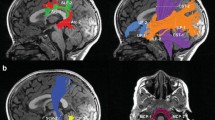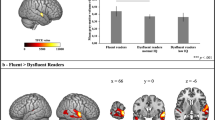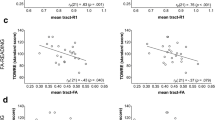Abstract
Reading, an essential life skill in modern society, is typically learned during childhood. Adults who can read show white matter differences compared to adults who never learned to read. Studies have not established whether children who can read show similar white matter differences compared to children who cannot read. We compared 6-year old children who could decode written English words and pseudowords (n = 31; Readers) and 6-year old children who could not decode pseudowords and had a standard score <100 on a task for reading single words (n = 11; Pre-readers). We employed diffusion MRI and tractography to extract fractional anisotropy (FA) along the trajectory of six bilateral intra-hemispheric tracts and two posterior subdivisions of the corpus callosum. Readers demonstrated significantly increased FA within the left anterior segment of the superior longitudinal fasciculus (aSLF-L) and the right uncinate fasciculus (UF-R) compared to Pre-readers. FA in the aSLF-L was significantly correlated with phonological awareness; FA in the UF-R was significantly correlated with language. Correlations in the UF-R but not the aSLF-L remained significant after controlling for reading ability, revealing that UF-R group differences were related to both children’s language and reading abilities. Taken together, these findings demonstrate new evidence showing that individual differences in white matter structure relate to whether children have begun to read.



Similar content being viewed by others
References
Assaf Y, Blumenfeld-Katzir T, Yovel Y, Basser PJ (2008) AxCaliber: a method for measuring axon diameter distribution from diffusion MRI. Magn Reson Med 59:1347–1354
Basser PJ, Pierpaoli C (1996) Microstructural and physiological features of tissues elucidated by quantitative-diffusion-tensor MRI. J Magn Reson 111:209–219
Beaulieu C (2002) The basis of anisotropic water diffusion in the nervous system—a technical review. NMR Biomed 15:435–455
Beaulieu C, Plewes C, Paulson LA, Roy D, Snook L, Concha L, Phillips L (2005) Imaging brain connectivity in children with diverse reading ability. NeuroImage 25:1266–1271
Benjamini Y, Hochberg Y (1995) Controlling the false discovery rate: a practical and powerful approach to multiple testing. J R Stat Soc 57:289–300
Ben-Shachar M, Dougherty RF, Wandell BA (2007) White matter pathways in reading. Curr Opin Neurobiol 17:258–270
Brauer J, Anwander A, Perani D, Friederici AD (2013) Dorsal and ventral pathways in language development. Brain Lang 127:289–295
Carreiras M, Seghier ML, Baquero S, Estévez A, Lozano A, Devlin JT, Price CJ (2009) An anatomical signature for literacy. Nature 461:983–986
Castles A, Coltheart M (2004) Is there a causal link from phonological awareness to success in learning to read? Cognition 91:77–111
Castro-Caldas A, Miranda PC, Carmo I, Reis A, Leote F, Ribeiro C, Ducla-Soares E (1999) Influence of learning to read and write on the morphology of the corups callosum. Eur J Neurol 6:23–28
Catani M, Jones DK, Ffytche DH (2005) Perisylvian language networks of the human brain. Ann Neurol 57:8–16
Catani M, Allin MP, Husain M, Pugliese L, Mesulam MM, Murray RM, Jones DK (2007) Symmetries in human brain language pathways correlate with verbal recall. Proc Natl Acad Sci 104:17163–17168
Catts HW, Fey ME, Zhang X, Tomblin JB (1999) Language basis of reading and reading disabilities: evidence from a longitudinal investigation. Sci Stud Read 3:331–361
Chang LC, Jones DK, Pierpaoli C (2005) RESTORE: robust estimation of tensors by outlier rejection. Magn Reson Med 53:1088–1095
Conturo TE, Lori NF, Cull TS, Akbudak E, Snyder AZ, Shimony JS, McKinstry RC, Burton H, Raichle ME (1999) Tracking neuronal fiber pathways in the living human brain. Proc Natl Acad Sci USA 96:10422–10427
Cummine J, Dai W, Borowsky R, Gould L, Rollans C, Boliek C (2015) Investigating the ventral-lexical, dorsal-sublexical model of basic reading processes using diffusion tensor imaging. Brain Struct Funct 220:445–455
De Santis S, Drakesmith M, Bells S, Assaf Y, Jones DK (2014) Why diffusion tensor MRI does well only some of the time: variance and covariance of white matter tissue microstructure attributes in the living human brain. NeuroImage 89:35–44
Deheane S (2009) Reading in the brain: the science and evolution of human invention. Viking Penguin, New York
Deutsch GK, Dougherty RF, Bammer R, Siok WT (2005) Children’s reading performance is correlated with white matter structure measured by diffusion tensor imaging. Cortex 41:354–363
Dick AS, Tremblay P (2012) Beyond the arcuate fasciculus: consensus and controversy in the connectional anatomy of language. Brain 135:3529–3550
Dougherty RF, Ben-Shachar M, Bammer R, Brewer AA, Wandell BA (2005) Functional organization of human occipital–callosal fiber tracts. Proc Natl Acad Sci USA 102:7350–7355
Dougherty RF, Ben-Shachar M, Deutsch GK, Hernandez A, Fox GR, Wandell BA (2007) Temporal-callosal pathway diffusivity predicts phonological skills in children. Proc Natl Acad Sci 104:8556–8561
Duffau H (2008) The anatomo-functional connectivity of language revisited. New insights provided by electrostimulation and tractography. Neuropsychologia 46:927–934
Duffau H, Capelle L, Sichez N, Denvil D, Lopes M, Sichez J-P, Bitar A, Fohanno D (2002) Intraoperative mapping of the subcortical language pathways using direct stimulation. An anatomo-functional study. Brain 125:199–214
Duffau H, Gatignol P, Denvil D, Lopes M, Capelle L (2003) The articulatory loop: study of the subcortical connectivity by electrostimulation. Neuroreport 14:2005–2008
Feldman HM, Lee ES, Yeatman JD, Yeom KW (2012) Language and reading skills in school-aged children and adolescents born preterm are associated with white matter properties on diffusion tensor imaging. Neuropsychologia 50:3348–3362
Friston KJ, Ashburner J (2004) Generative and recognition models for neuroanatomy. Neuroimage 23:21–24
Frye RE, Hasan K, Xue L, Strickland D, Malmberg B, Liederman J, Papanicolaou A (2008) Splenium microstructure is related to two dimensions of reading skill. Neuroreport 19:1627–1631
Gough PB, Tunmer WE (1986) Decoding, reading, and reading disability. Remedial Spec Educ 7:6–10
Groeschel S, Tournier JD, Northam GB, Baldeweg T, Wyatt J, Vollmer B, Connelly A (2014) Identification and interpretation of microstructural abnormalities in motor pathways in adolescents born preterm. Neuroimage 87:209–219
Gullick MM, Booth JR (2014) Individual differences in crossmodal brain activity predict arcuate fasciculus connectivity in developing readers. J Cogn Neurosci 26:1331–1346
Gullick MM, Booth JR (2015) The direct segment of the arcuate fasciculus is predictive of longitudinal reading change. Dev Cogn Neurosci 13:68–74
Hickok G, Poeppel D (2004) Dorsal and ventral streams: a framework for understanding aspects of the functional anatomy of language. Cognition 92:67–99
Hoeft F, Ueno T, Reiss AL, Meyler A, Whitfield-Gabrieli S, Glover GH, Keller TA, Kobayashi N, Mazaika P, Jo B, Just MA, Gabrieli JDE (2007) Prediction of children’s reading skills using behavioral, functional, and structural neuroimaging measures. Behav Neurosci 121:602
Hollingshead A (1975) Four factor index of social status. Yale University, New Haven
Hua K, Zhang J, Wakana S, Jiang H, Li X, Reich DS, Calabresi PA, Pekar JJ, van Zijl PC, Mori S (2008) Tract probability maps in stereotaxic spaces: analyses of white matter anatomy and tract-specific quantification. Neuroimage 39:336–347
Huang H, Zhang J, Jiang H, Wakana S, Poetscher L, Miller MI, van Zijl PC, Hillis AE, Wytik R, Mori S (2005) DTI tractography based parcellation of white matter: application to the mid-sagittal morphology of corpus callosum. Neuroimage 26:195–205
Johnson RT, Yeatman JD, Wandell BA, Buonocore MH, Amaral DG, Nordahl CW (2013) Diffusion properties of major white matter tracts in young, typically developing children. Neuroimage 88:143–154
Jones DK, Cercignani M (2010) Twenty-five pitfalls in the analysis of diffusion MRI data. NMR Biomed 23:803–820
Keller TA, Just MA (2009) Altering cortical connectivity: remediation-induced changes in the white matter of poor readers. Neuron 64:624–631
Kirby JR, Desrochers A, Roth L, Lai S (2008) Longitudinal predictors of word reading development. Can Psychol 49:103–110
Langer N, Peysakhovich B, Zuk J, Drottar M, Sliva DD, Smith S, Becker BL, Grant PE, Gaab N (2015) White matter alterations in infants at risk for developmental dyslexia. Cereb Cortex pii: bhv281 [Epub ahead of print]
Lebel C, Beaulieu C (2009) Lateralization of the arcuate fasciculus from childhood to adulthood and its relation to cognitive abilities in children. Hum Brain Mapp 30:3563–3573
Lebel C, Beaulieu C (2011) Longitudinal development of human brain wiring continues from childhood into adulthood. J Neurosci 31:10937–10947
Lebel C, Gee M, Camicioli R, Wieler M, Martin W, Beaulieu C (2012) Diffusion tensor imaging of white matter tract evolution over the lifespan. Neuroimage 60:340–352
Leemans A, Jones DK (2009) The B-matrix must be rotated when correcting for subject motion in DTI data. Magn Reson Med 61:1336–1349
Levene H (1960) Robust tests for equality of variances. Stanford University Press, Stanford
Martino J, De Witt Hamer PC, Berger MS, Lawton MT, Arnold CM, de Lucas EM, Duffau H (2013) Analysis of the subcomponents and cortical terminations of the perisylvian superior longitudinal fasciculus: a fiber dissection and DTI tractography study. Brain Struct Funct 218:105–121
Mauchly JW (1940) Significance test for sphericity of a normal n-variate distribution. Ann Math Stat 11:204–209
McDonald CR, Ahmadi ME, Hagler DJ, Tecoma ES, Iragui VJ, Gharapetian L, Dale AM, Halgren E (2008) Diffusion tensor imaging correlates of memory and language impairments in temporal lobe epilepsy. Neurology 71:1869–1876
Melby-Lervag M, Lyster S-AH, Hulme C (2012) Phonological skills and their role in learning to read: a meta-analytic review. Psychol Bull 138:322–352
Mezer A, Yeatman JD, Stikov N, Kay KN, Cho NJ, Dougherty RF, Perry ML, Parvizi J, le Hua H, Butts-Pauly K, Wandell BA (2013) Quantifying the local tissue volume and composition in individual brains with magnetic resonance imaging. Nat Med 19:1667–1672
Mishra A, Anderson AW, Wu X, Gore JC, Ding Z (2010) An improved Bayesian tensor regularization and sampling algorithm to track neuronal fiber pathways in the language circuit. Med Phys 37:4274–4287
Monzalvo K, Dehaene-Lambertz G (2013) How reading acquisition changes children’s spoken language network. Brain Lang 127:356–365
Mori S, Crain BJ, Chacko V, Van Zijl P (1999) Three-dimensional tracking of axonal projections in the brain by magnetic resonance imaging. Ann Neurol 45:265–269
Myers CA, Vandermosten M, Farris EA, Hancock R, Gimenez P, Black JM, Casto B, Drahos M, Tumber M, Hendren RL, Hulme C, Hoeft F (2014) white matter morphometric changes uniquely predict children’s reading acquisition. Psychol Sci 25:1870–1883
Nagy Z, Westerberg H, Klingberg T (2004) Maturation of white matter is associated with the development of cognitive functions during childhood. J Cogn Neurosci 16:1227–1233
NICHD Early Child Care Research Network (2005) Pathways to reading: the role of oral language in the transition to reading. Dev Psychol 41:428–442
Nichols TE, Holmes AP (2002) Nonparametric permutation tests for functional neuroimaging: a primer with examples. Hum Brain Mapp 15:1–25
Niogi SN, McCandliss BD (2006) Left lateralized white matter microstructure accounts for individual differences in reading ability and disability. Neuropsychologia 44:2178–2188
Odegard TN, Farris EA, Ring J, McColl R, Black J (2009) Brain connectivity in non-reading impaired children and children diagnosed with developmental dyslexia. Neuropsychologia 47:1972–1977
Oldfield RC (1971) The assessment and analysis of handedness: the Edinburgh inventory. Neuropsychologia 9:97–113
Papagno C (2011) Naming and the role of the uncinate fasciculus in language function. Curr Neurol Neurosci Rep 11:553–559
Press W, Teukolsky S, Vetterling W, Flannery B (2002) Numerical recipes in C++: the art of scientific computing. Cambridge University Press, Cambridge
Price CJ (2012) A review and synthesis of the first 20 years of PET and fMRI studies of heard speech, spoken language and reading. Neuroimage 62:816–847
Qiu D, Tan LH, Zhou K, Khong PL (2008) Diffusion tensor imaging of normal white matter maturation from late childhood to young adulthood: voxel-wise evaluation of mean diffusivity, fractional anisotropy, radial and axial diffusivities, and correlation with reading development. Neuroimage 41:223–232
Reese TG, Heid O, Weisskoff RM, Wedeen VJ (2003) Reduction of eddy-current-induced distortion in diffusion MRI using a twice-refocused spin echo. Magn Reson Med 49:177–182
Rimrodt SL, Peterson DJ, Denckla MB, Kaufmann WE, Cutting LE (2010) White matter microstructural differences linked to left perisylvian language network in children with dyslexia. Cortex 46:739–749
Rohde GK, Barnett AS, Basser PJ, Marenco S, Pierpaoli C (2004) Comprehensive approach for correction of motion and distortion in diffusion-weighted MRI. Magn Reson Med 51:103–114
Ryan C (2013) Language use in the United States: 2011. American Community Survey Reports
Saygin ZM, Norton ES, Osher DE, Beach SD, Cyr AB, Ozernov-Palchik O, Yendiki A, Fischl B, Gaab N, Gabrieli JDE (2013) Tracking the roots of reading ability: white matter volume and integrity correlate with phonological awareness in prereading and early-reading kindergarten children. J Neurosci 33:13251–13258
Share DL (1995) Phonological recoding and self-teaching: sine qua non of reading acquisition. Cognition 55:151–218
Snowling M, Dawes P, Nash H, Hulme C (2012) Validity of a protocol for adult self-report of dyslexia and related difficulties. Dyslexia 18:1–15
Song S-K, Sun S-W, Ramsbottom MJ, Chang C, Russell J, Cross AH (2002) Dysmyelination revealed through MRI as increased radial (but unchanged axial) diffusion of water. Neuroimage 17:1429–1436
Song SK, Yoshino J, Le TQ, Lin SJ, Sun SW, Cross AH, Armstrong RC (2005) Demyelination increases radial diffusivity in corpus callosum of mouse brain. Neuroimage 26:132–140
Storch SA, Whitehurst GJ (2002) Oral language and code-related precursors to reading: evidence from a longitudinal structural model. Dev Psychol 38:934–947
Tardif CL, Gauthier CJ, Steele CJ, Bazin PL, Schafer A, Schaefer A, Turner R, Villringer A (2015) Advanced MRI techniques to improve our understanding of experience-induced neuroplasticity. Neuroimage 131:55–72
Thiebaut de Schotten M, Cohen L, Amemiya E, Braga LW, Dehaene S (2014) Learning to read improves the structure of the arcuate fasciculus. Cereb Cortex 24:989–995
Travis KE, Adams JN, Ben-Shachar M, Feldman HM (2015a) Decreased and increased anisotropy along major cerebral white matter tracts in preterm children and adolescents. PLoS One 10:e0142860
Travis KE, Golden NH, Feldman HM, Solomon M, Nguyen J, Mezer A, Yeatman JD, Dougherty RF (2015b) Abnormal white matter properties in adolescent girls with anorexia nervosa. Neuroimage 9:648–659
Tsang JM, Dougherty RF, Deutsch GK, Wandell BA, Ben-Shachar M (2009) Frontoparietal white matter diffusion properties predict mental arithmetic skills in children. Proc Natl Acad Sci USA 106:22546–22551
Vanderauwera J, Vandermosten M, Dell’Acqua F, Wouters J, Ghesquiere P (2015) Disentangling the relation between left temporoparietal white matter and reading: a spherical deconvolution tractography study. Hum Brain Mapp 36:3273–3287
Vandermosten M, Boets B, Poelmans H, Sunaert S, Wouters J, Ghesquiere P (2012a) A tractography study in dyslexia: neuroanatomic correlates of orthographic, phonological and speech processing. Brain 135:935–948
Vandermosten M, Boets B, Wouters J, Ghesquiere P (2012b) A qualitative and quantitative review of diffusion tensor imaging studies in reading and dyslexia. Neurosci Biobehav Rev 36:1532–1552
Vandermosten M, Vanderauwera J, Theys C, De Vos A, Vanvooren S, Sunaert S, Wouters J, Ghesquiere P (2015) A DTI tractography study in pre-readers at risk for dyslexia. Dev Cogn Neurosci 14:8–15
Von Der Heide RJ, Skipper LM, Klobusicky E, Olson IR (2013) Dissecting the uncinate fasciculus: disorders, controversies and a hypothesis. Brain 136:1692–1707
Waber DP, De Moor C, Forbes PW, Almli CR, Botteron KN, Leonard G, Milovan D, Paus T, Rumsey J, Brain Development Cooperative Group (2007) The NIH MRI study of normal brain development: performance of a population based sample of healthy children aged 6 to 18 years on a neuropsychological battery. J Int Neuropsychol Soc 13:729–746
Wagner R, Torgesen J, Rashotte C (1999) Comprehensive test of phonological processing: CTOPP: Pro-Ed
Wakana S, Jiang H, Nagae-Poetscher LM, van Zijl PC, Mori S (2004) Fiber tract-based atlas of human white matter anatomy. Radiology 230:77–87
Wandell BA, Yeatman JD (2013) Biological development of reading circuits. Curr Opin Neurobiol 23:261–268
Webb AR, Heller HT, Benson CB, Lahav A (2015) Mother’s voice and heartbeat sounds elicit auditory plasticity in the human brain before full gestation. Proc Natl Acad Sci USA 112:3152–3157
Wechsler D, Hsiao-pin C. 2011. WASI-II: Wechsler abbreviated scale of intelligence: Pearson
Welch BL (1947) The generalization of Student’s problem when several different population variances are invovled. Biometrika 34:28–35
Welcome SE, Joanisse MF (2014) Individual differences in white matter anatomy predict dissociable components of reading skill in adults. Neuroimage 96:261–275
Wigg E, Secord W, Semel E (2003) Clinical evaluation of langauge fundamentals (CELF-4). Hartcourt Psychology Corporation Assessments Inc, San Antonio
Woodcock RW (2011) Woodcock reading mastery test, 3rd edn. Pearson, San Antonio
Yeatman JD, Dougherty RF, Rykhlevskaia E, Sherbondy AJ, Deutsch GK, Wandell BA, Ben-Shachar M (2011) Anatomical properties of the arcuate fasciculus predict phonological and reading skills in children. J Cogn Neurosci 23:3304–3317
Yeatman JD, Dougherty RF, Ben-Shachar M, Wandell BA (2012a) Development of white matter and reading skills. Proc Natl Acad Sci USA 109:E3045–E3053
Yeatman JD, Dougherty RF, Myall NJ, Wandell BA, Feldman HM (2012b) Tract profiles of white matter properties: automating fiber-tract quantification. PLoS One 7:e49790
Yeatman JD, Weiner KS, Pestilli F, Rokem A, Mezer A, Wandell BA (2014) The vertical occipital fasciculus: a century of controversy resolved by in vivo measurements. PNAS E5214–E5223
Acknowledgments
We thank the children and families who participated in our study.
Author information
Authors and Affiliations
Corresponding author
Ethics declarations
Funding
This work was supported by the Eunice Kennedy Shriver National Institutes of Child Health and Human Development at the National Institutes of Health (Grant Numbers RO1-HD69162, RO1-HD46500); the I-CORE Program of the Planning and Budgeting Committee; and The Israel Science Foundation (Grant Number 51/11) to MB-S.
Additional information
K. E. Travis and J. N. Adams contributed equally to the manuscript and share the position of first author.
Electronic supplementary material
Below is the link to the electronic supplementary material.
Rights and permissions
About this article
Cite this article
Travis, K.E., Adams, J.N., Kovachy, V.N. et al. White matter properties differ in 6-year old Readers and Pre-readers. Brain Struct Funct 222, 1685–1703 (2017). https://doi.org/10.1007/s00429-016-1302-1
Received:
Accepted:
Published:
Issue Date:
DOI: https://doi.org/10.1007/s00429-016-1302-1




